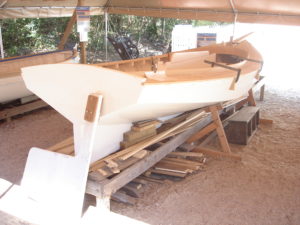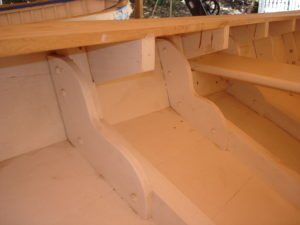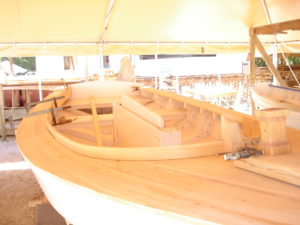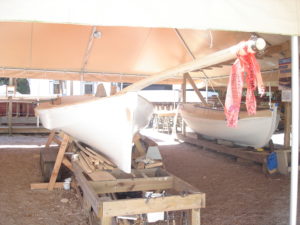The building of an authentic replica of a traditional fishing craft called a Florida skipjack was begun with a grant award from the Community Foundation from Northeast Florida. The Crisp-Ellert Grant is one that supports the arts and the Foundation has acknowledged that traditional wooden boat carpentry is an art form. The mission of the Heritage Boatworks at the St. Augustine Lighthouse & Maritime Museum is to “recover, preserve, and pass on the traditional art of boat carpentry as practiced in St. Augustine”, and with a 451 year tradition of building wooden craft in St. Augustine, the Heritage Boatworks have plenty to choose from.
 View of the skipjack toward the starboard stern quarter
View of the skipjack toward the starboard stern quarter
The design of the craft originated in Essex on the Connecticut River and was brought to Northeast Florida by a Captain Watrous around 1850. The skipjack under construction is a replica of a craft that was originally built on the St. Johns River in New Berlin, outside of Jacksonville between 1875 and 1880. During the Great Depression in October, 1936, the craft was documented as part of a WPA project called the Historic American Merchant Marine Survey (HAMMS). Her dimensions, fastening, manner of framing, and the type of woods that went into her construction were all recorded in some 26 pages of field notes with measured drawings and photographs the end product of which became a set of ship lines that were drafted from all the collected data. This information was obtained from the Smithsonian Institution in Washington D.C. where all the records from the HAMMS project are archived. These lines and notes were used by the Boatworks to project and replicate the shape of the hull.
Begun in June of 2014, she has taken shape to the point where she is today. This craft, with only a few exceptions, is built entirely of Florida cypress. The exceptions to this rule are her gussets which reinforce her frame, or rib, joinery, and her pivoted center board. These are all made of Florida live oak, one of the strongest, densest, and most rot resistant woods known to ship building.
 Image of the flying bird shaped gussets holding together the elements of the frames
Image of the flying bird shaped gussets holding together the elements of the frames
The most recent work has included the installation of her decking as well as the fitting and mounting her bowsprit. The combing around her open interior has recently been steamed and shaped and is undergoing final fitting before installation.
 View from the bow showing the decking and combing shielding the interior from the sea
View from the bow showing the decking and combing shielding the interior from the sea
In addition to these major works on the hull, some fine craftsmanship is also being performed on some of the other fittings and rigging components. These include cleats, line guides, and blocks for the running rigging. Soon we will begin construction of her hollow bird’s mouth mast and yard for her lug rigged sail. A large jib will fly forward from the top of the mast to the end of her bowsprit and should make an impressive site as she sails out on Matanzas Bay in the future.
View from the bow showing the bowsprit
We are without a doubt deeply indebted to all of our volunteer boatbuilders who bring wood and sail cloth together to create craft of unsurpassed quality and beauty. They are true artisans in every sense of the word.


